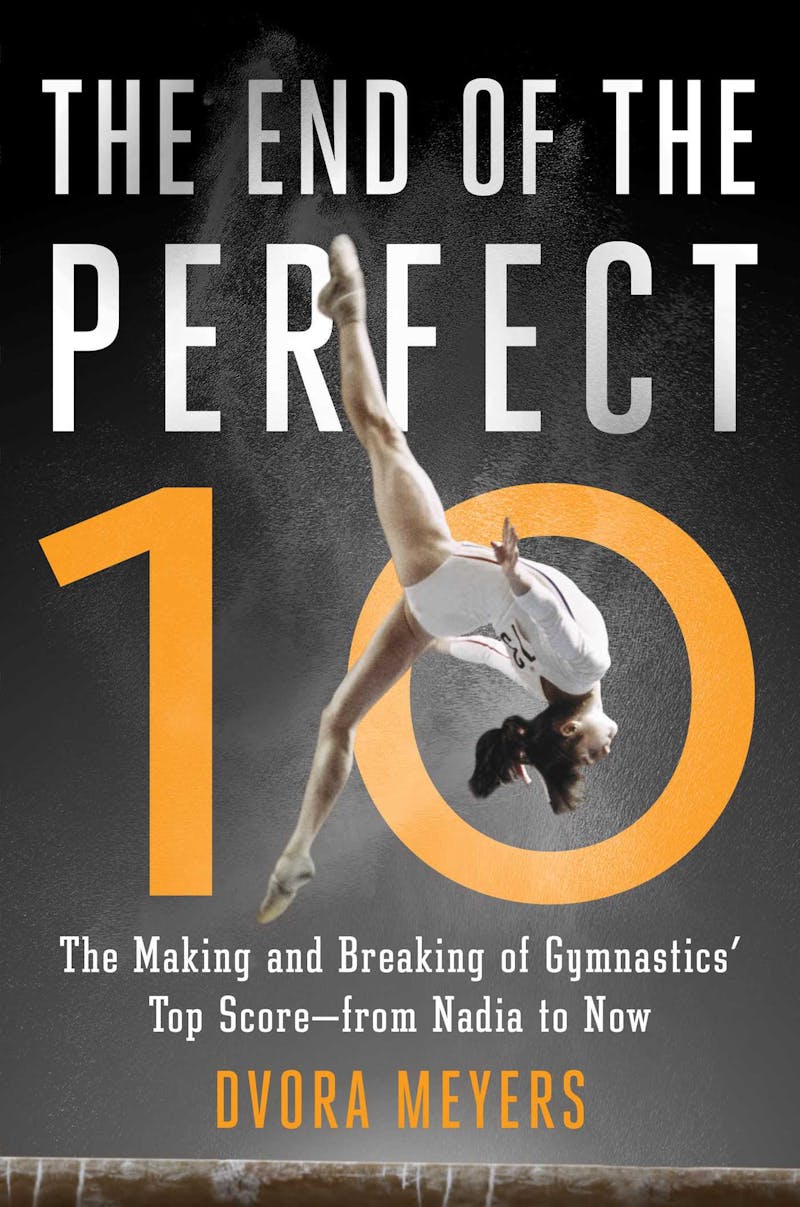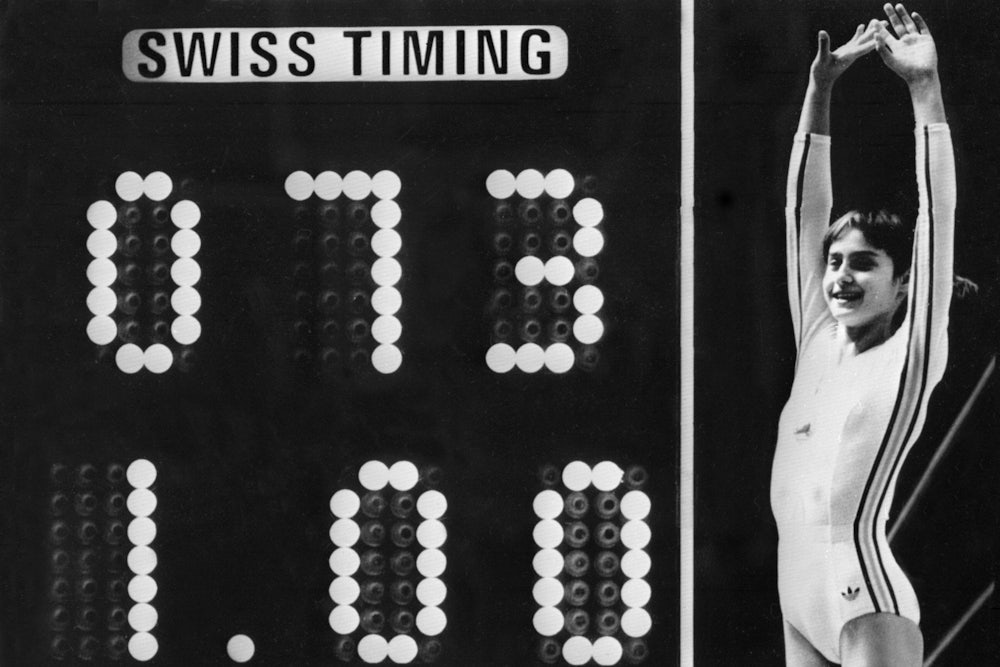When Romanian gymnast Nadia Comaneci competed at the 1976 Olympics, the legend goes, she was powerful enough not just to dazzle an audience of millions, but to break the very equipment that was meant to calculate her score. In this case, the legend is true. After Nadia dismounted from the uneven bars, the digital scoreboard displayed a 1.00. Despite the fact that Olympic gymnastics routines were scored out of 10, the manufacturers of the equipment used at the Montreal Games had apparently never imagined that there might be a gymnast who would actually receive a perfect score.

In the forty years since, we have grappled with the question of what such a score really means—what kind of athlete it is reserved for, and which aspects of gymnastics it is powerless to describe. Now, on the eve of the Rio Olympics, sports journalist and former gymnast Dvora Meyers has written The End of the Perfect 10, a gripping analysis not just of the gymnastics world, but of what our desire for perfection does to us as athletes and as viewers.
The perfect 10 made fourteen-year-old Nadia Comaneci a living legend, and made women’s gymnastics one of the most hotly anticipated and avidly watched events in American Olympic coverage. For one brief moment, national borders and lingering Cold War hostilities ceased to matter. The world was in love with Nadia. At the Games, scalpers sold tickets to the gymnastics events, originally priced at sixteen dollars, for two hundred. When ABC’s Wide World of Sports unearthed an obscure piece of instrumental music, renamed it “Nadia’s Theme,” and paired it with a montage of Nadia’s Olympic performances, the association alone was enough to propel it to the top of the Billboard charts.
Even Nadia’s dimensions were interesting. She had, E.J. Kahn wrote in The New Yorker, “become her country’s most valuable foreign exchange asset, worth incalculable times her weight (eighty-eight pounds) in gold.” She was, Newsweek’s Pete Axthelm wrote, a “child-heroine,” a “princess,” a “ballerina,” and a “doll-like symbol of what’s still right with the Games.” She was better than stunning, better than beautiful, better than great; she was perfect. Who could resist such a force?
As it turned out, the only person who wasn’t spellbound by the perfect 10 was Nadia Comaneci herself. How did it feel, reporters asked breathlessly, to have won so many gold medals, to be so adored, so admired? “It’s nothing special,” she said. “I feel just the same as before.” Had she ever worried the gold might elude her? “No,” she said. “I knew I would win.” How had she become so strong, so talented, so successful? “I am so good,” she responded patiently, “because I work very hard for it.” The rest of the world might have seen Comaneci as a child wonder strewn with pixie dust, but she saw herself as an athlete.
Though Nadia was the first female gymnast awarded a 10 in the Olympics, she was soon followed by Soviet gymnast Nellie Kim, who left the 1976 Games with two individual gold medals to Nadia’s three. Yet her fame has faded, while Nadia’s legendary status has only grown. Why? For Dvora Meyers, this question is at the heart of The End of the Perfect 10, and its exploration of sports, strength, and gender. “Even in that magical Olympic Games when the first 10s were electrifying the audience,” Meyers writes, “the limits of the perfect mark were already in evidence.”
Nadia Comaneci and Nellie Kim may have shared a score, but they took very different approaches to gymnastics: Comaneci perfected her performance of the sport’s elements, while Kim was an innovator. Yet despite performing a vault at the 1976 Games that was, in Meyers’ estimation, “years ahead of its time…Kim’s 10 did not leap ahead of the field on the event.” The 10 was only enough to put her a around a tenth of a point above the event’s other competitors—a way of saying not that Kim was perfect, but that she had edged past the other gymnasts.
Part of the lure of the perfect 10, at least as far as audiences were concerned, was its simplicity. Yet, as Meyers explains, Nellie Kim’s 10 was as different from Nadia Comaneci’s as the two athletes were from each other. Unlike Comaneci’s score, Meyers writes, Kim’s 10
wasn’t about the purity of her technique or the lines of her body. It was a very hard vault done extremely well. For Kim, the 10 was more score than symbol. It didn’t necessarily signify anything about her as a gymnast… didn’t express perfection as much as a lack of missteps; but in the eyes of viewers, Comaneci’s wasn’t the errorless 10, it was the perfect 10—but, why?
That “why” is the engine of The End of the Perfect 10, and it takes us all the way from the 1976 Olympics to the upcoming Games in Rio.
Nadia Comaneci’s groundbreaking perfect 10 ushered in an era of imperfect 10s: perfect scores awarded for routines that had visible flaws, handed out by judges who had scored previous competitors so generously that they had no way to acknowledge a superior performance except by deeming it perfect. At the 1988 Olympics, forty perfect 10s were awarded to fourteen separate gymnasts. Even the idea of perfection began to lose its luster when it was marshaled not in service of a once-in-a-lifetime phenomenon, but awarded dozens of times in a single Games. “If everyone’s vaults are worth a 10,” Meyers asks, “then how do you reward a gymnast who has pushed the envelope?”
Beyond the issue of score inflation, Meyers notes, Olympic judges make mistakes, and national allegiances also have a way of influencing scoring. (These issues also plagued the figure skating world, and would come to a head in the pairs competition at the 2002 Olympics, spurring the adoption of a new scoring system in that sport.) “But,” Meyers notes, “there is a way to view the proliferation of 10s other than through the lens of incompetence or corruption. All of those 10s could also be read as a sign that Comaneci and her gymnastics descendants had mastered and surpassed the rules. And so started the cycle of rule revisions.”
Ultimately, The End of the Perfect 10 is far less about the death of a benchmark score than it is about the birth of a new era in gymnastics. The last perfect 10 to be awarded to a gymnast in Olympic competition went to Romanian Lavinia Milosovici, at the 1992 Games. Since then, generation after generation of gymnasts have continued to surpass the skills that earned Nadia Comaneci the first perfect 10. Women’s gymnastics changed, gradually but unrelentingly, from a performance that emphasized perfection—the perfect dismount, the perfect body, the perfect girl—to something far more recognizable as a sport. The scoring system currently in place may not be as simple as the perfect 10, but it reflects a sport that is anything but simple, and rewards gymnasts for pushing the limits of their discipline.
“Gymnasts have become athletes,” a fellow journalist tells Meyers in The End of the Perfect 10. “They perform solid routines, work hard, and go out there and enjoy themselves.” Perhaps more than anything, the idea of women’s gymnastics being a sport that its practitioners actually enjoy—an act not of feminine masochism, but of strategy, bravura, even play—demonstrates just how much the gymnastics world has changed since 1976.
Meyers’s book pays close attention to the gradual evolution, both technical and cultural, that allowed this change to take place. She explains not just the gymnastics world as a whole, but key details that distinguish this routine from that one—the elements of this dismount or that vault—and that mean the difference between winning and losing, and between an athlete being remembered or forgotten. Yet, for all its usefulness as a crib sheet for anyone who wants to understand this year’s Olympic events, rather than just marveling at them, The End of the Perfect 10 is about something even bigger than the gymnastics world itself. It shows us that we now live in a world where a young woman may captivate millions not through her alleged perfection, but through her dedication, daring, and strength.
As always, Nadia Comaneci is well ahead of us. When Dvora Meyers interviews her about those 10s, Comaneci simply says “I was rewarded for my work and innovation.” It took us forty years to realize Nadia Comaneci was not a “doll-like symbol” but an athlete. But she, at least, has always known this much to be true.
